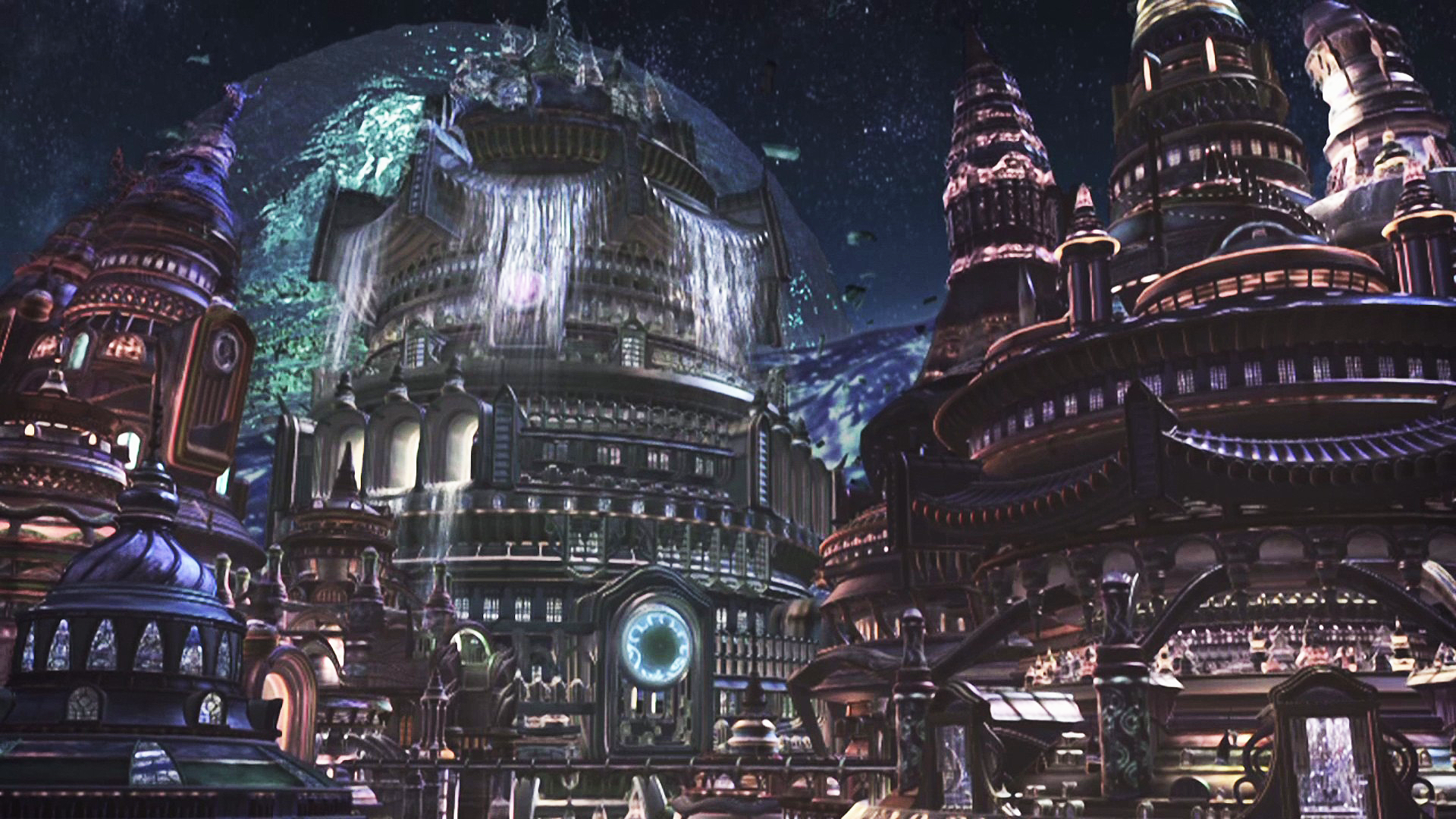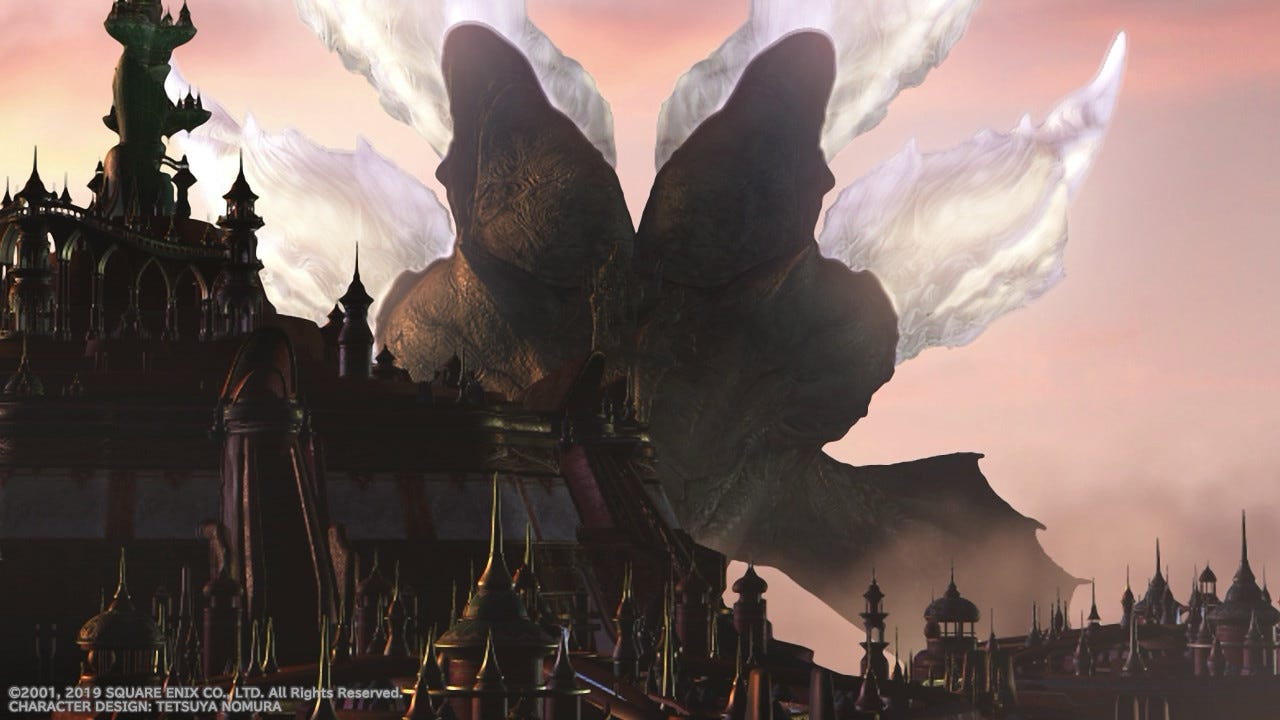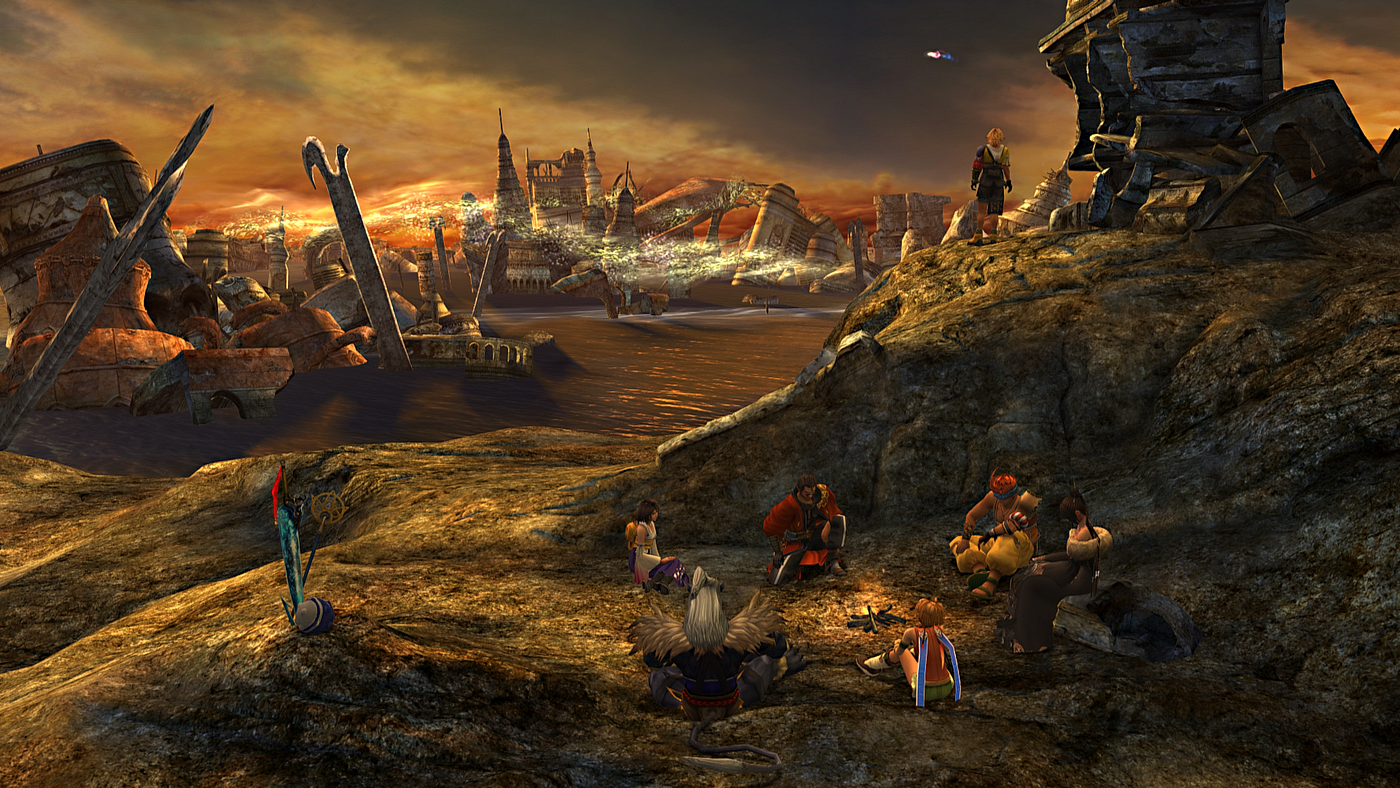Once Sacred, Now a Tourist Trap
Final Fantasy X-2 debates what makes a location sacred and worth preserving

From the temple in Besaid coated in sea salt to the submerged temple in Baaj, the Hymn of the Fayth echoes, the source of the song deep within. There is a tale of death and hope that looms in the statues of former summoners that flank its main halls. In the comforting gloom found in these temples, the faithful quietly offer prayers to the stony visages.
Final Fantasy X throws players into Spira, a world caught in a cycle of destruction and death thanks to a creature known as Sin. Spira’s dominant faith, Yevon, and its temples act as a constant light in the darkness. They are markers to an epic pilgrimage summoners take to break the cycle of destruction, if only for a moment.
These sacred spaces carry a morbid, yet romantic appeal.
Each feverish prayer in the depths of the temple by a summoner to be given more strength is a step deeper into the summoner’s own grave. Each statue that watches over the temple is the face of a summoner who never saw the fruits of their labor. Each bond between summoner and their guardians grows.
There are other sacred spaces outside of Yevon’s hallowed halls. A quiet campfire in a ruined city, a tucked away corner in the woods littered with pyreflies, and a whistle that cuts through the noise of a busy port-city.
So what happens to these sacred spaces when faith and society changes? When the locations of those moments fade?
Final Fantasy X-2 grapples with the purpose behind sacred landmarks — both religious and personal — that once supported Spira and debates if they should be preserved.

The Downfall of Sin & Yevon
Step into any temple and you can hear the voice of the one who gave their life to become part of the fayth. The powerful voice of Shiva in the Macalania temple to the haunting voice of a child in Bevelle. Each temple is powered not only by their sacrifice ages ago, but by the continual sacrifice of summoners.
Yevon’s teachings came to be long after the death of Yu Yevon, a powerful summoner and leader of Zanarkand. The teachings revolve solely around the existence of Sin. The temples push a false narrative that Sin came to be because of a heavy reliance on machina (machines) and humanity must atone.
As the people of Spira pray to Yevon for their Calm, are they ironically reaching out to the very person who created Sin. Sin came out Yevon’s desperate refusal to see their beloved city destroyed. Whatever humanity that once sat in Yevon has long ago eroded, cyclically destroying Spira through Sin without care.
Final Fantasy X exposes the misinformation and misunderstanding pushed by the temples. Its leaders knew the truth behind Sin, yet did nothing with such knowledge. They focused on growing and maintaining their collective and individual power. With each sacrifice by a summoner, the legitimacy of their authority grew.
With Sin’s defeat and the deception of Yevon leadership starting to reveal itself, the fate of Yevon’s teachings and temples becomes uncertain.

A Place To Worship
It’s hard for a world to collectively step away from its once dominant faith. Yevon’s teachings did not partake in a vacuum, but ingrained itself into everyday life in Spira.
Maesters became pillars within their own community. Summoners (although not all of them in religious leadership roles) were used to perform sendings to put the dead to rest. Sin’s defeat appeared only possible because of Yevon’s promotion of the Final Summoning, and temples acted as a way of bringing in commerce to their areas of the world.
New Yevon sprung up in what appeared as an attempt to fill the void that Sin’s demise left. However, this time, it’s prayers given in temples lit with simple firelight and without song. The fayth left the temples with Sin’s defeat, the magic that once set these places aglow gone.
Unfortunately, New Yevon did not honor its purpose. It became, instead, a way of preserving its temples and secrets.
Founded by Trema after Sin, he encouraged Yevonites to go about the world collecting spheres. Creating the sphere hunting craze we’re thrown in Final Fantasy X-2, it really was Trema trying to locate and destroy temple secrets. There was no genuine attempt to transform and improve the faith.
Final Fantasy X-2 continues to show the the harm of coverup and censorship by Yevon leadership, manifesting itself as Vegnagun. Which brings me to realize that it is not yet common knowledge that Sin and Yevon are one and the same. That the gripe people may actually have with the Yevon religion revolves more around the news of Maester Seymour’s genocide on the Ronsos, Operation Mi’ihen, and other instances of corruption.
So how do you support a population that will one day have to face that Yevon was once the source of all their misery? How do you cope with corruption within temple ranks? New Yevon’s answer is to bring in new leaders, preserve its temples, and keep a rendition of the faith as long as possible.
“The world is changing and there are many who are finding it difficult to keep up. New Yevon wishes to help those who feel lost in those winds of change.” — Baralai
I would argue that on a very human need, people need someone or something to believe in. Religion helped provide meaning to others during a gruesome timeline and even act as a social tool, allowing people to live in cooperative societies across Spira. With no other notable religions around, falling back on Yevon feels like a safe choice and provides a sense of comfort despite the known scandals.
As to how long this will last, only time will tell.

Danger Within The Temples
New Yevon’s existence and reluctance to share temple secrets has earned the ire of the Youth League, a secular organization that demands information be shared with everyone.
Tensions have grown over time between the two to the point of dividing up towns to actual combat. However, the argument to destroy Yevon’s temples floats around when fiends begin to pour out of them.
It’s further discovered that where the fayth once rested now lies a hole that leads deep to the Farplane. Fiends have been crawling through them and wrecking havoc, along with dark counterparts of aeons. Once a place a safety, temples have become hubs of fiend activity. It comes to a point where destroying the temples becomes a possible solution to protect the community.
“It would be so simple to burn this place down and take the fiends with it.” — Beclem
These passageways into the Farplane never were resolved in the game. While the group will use it to face the threat of Vegnagun, we never see how these entrances are sealed to prevent fiends from exiting in the future. While the temples so far remain intact, people do view them as a potential safety issue.

To Remember Those Who Are Gone
This argument comes vividly through Yuna for most of the game, her words helping to define the meaning behind sacred spaces outside a religious perspective.
For her, spaces she saw as sacred stood as monuments that immortalized people and events of the past. When her father went on his pilgrimage to fight Sin, it was Jecht (Tidus’ father) who recorded their journey. Yuna and her guardians never recorded their time together. There are no spheres of her with Auron or with Tidus.
It’s why Macalania Woods, Zanarkand, and the temples hold a close place in Yuna’s heart. These are locations where she once shared cherished moments with those she lost. If these locations drastically transform or fade, it forces her to come to terms that they are truly gone.
Yuna uses these physical locations as a way of gauging the strength of her memory and their presence in her life. If the area can stay as it is, she can keep them with her a bit longer.

Another reason behind Yuna’s insistence to protect these locations is to pay her respects to those who fought Sin — guardians and aeons alike.
Seeing Zanarkand become transformed into a tourist trap feels like an affront to those who lost their lives here. Even in conversations with Beclem, a Youth League member, it’s obvious that there are some in Spira who doubt and devalue her journey to help achieve the Eternal Calm.
My pilgrimage was successful because my friends and the aeons supported me along the way. And they still do. Memories of the time we spent together make me strong. — Yuna
These interactions are a sharp reminder to Yuna that not many will share the visceral reaction and bond she has with this location. Rikku is the one who has to explain to her father, Cid, that turning Zanarkand into a tourist attraction is equivalent to turning the ruins of Home into one. Not much of Spira grasps the importance and the heartache that permanently takes shelter in Zanarkand’s ruins. I’d argue it’s a mix of distance from these events, conflict with Yevon temples that lumps summoners in, and genuine lack of education on what is endured during pilgrimages.
As time passes, the significance behind Zanarkand will lessen. Isaaru warning that if he doesn’t keep his eyes on this location, it will disappear entirely from Spira’s memory.
So how do you help others understand the significance of an event and remember it as time passes? Temples served as a location where former summoners could be remembered and respected. If temples end up destroyed later on or its architecture changes (statues removed), where will Spira provide space to remember them?

A Space to Grow
Another argument that is introduced is repurposing temples and other sacred landmarks to make space for not only other groups, but to house a growing population.
One of the defining features of Sin was that it targeted heavily populated areas, making it difficult for Spira’s population to grow. With Sin out of the picture, Spira now has that opportunity.
Spira may see itself urbanizing with towns turning into cities and more livable spaces popping up. Without the threat of Sin, there is bound to be a significant jump in population size and lifespan amongst Spirians.
In addition, we no longer see (at least from what we can see) Al Bheds being ostracized by society. We see Al Bheds making their home all across Spira. Some have even repurposed the abandoned Djose Temple as a base for the Machine Faction. Thanks to the Al Bheds, we see machines (machina) being reintroduced into society, leading to significant leaps in Spira’s wellbeing.
There is an increase in travel, information is more accessible (spherecasts), and businesses can grow. These boons have led to areas that were once inhabitable habitable.
For example, the Calm Lands once was part of the last stretch of a summoner’s pilgrimage and the location of a battle with Sin ages ago. Prior to Sin’s defeat, it was nothing more than a stretch of inhabited land. Now, it’s a place where you can play games. The space has the potential to be transformed even further into a location where one could live and thrive.
On the other hand, we see areas that were connected to the fayth like the Macalania Woods die. Without the fayth, the woods cannot sustain themselves. While this means the loss of homes for spirits like the Musicians, they do end up gaining new homes in Guadosalam.
Life finds a way to continue. Who knows, perhaps out of the wood’s ruins could something new take root.

To Preserve or Not To Preserve
Final Fantasy X-2 grapples with the purpose behind sacred landmarks and uses the perspectives of different groups and individuals to debate what is to be done with them.
Should they remain as they are to help those who feel overwhelmed with how quickly Spira is changing? Should they remain preserved to honor and memorialize those who sacrificed their lives? Or are these spaces relics of the past that need to find new purpose or be destroyed?
Final Fantasy X-2 settles the debate through Yuna near the final chapter. She cannot stop the world from changing so she can continue to physically hold on to the past. It doesn’t mean Yuna has to come to terms with that truth now, but it’s one she can’t ignore.
Coming to terms with that change will always be messy and painful, as we see in Spira with its clash of different organizations and ideas. However, moving forward and seeing locations transform doesn’t mean letting memories, people, and sacrifices go forgotten. All three leaders of Spira’s factions will even admit that the division they created came from allowing themselves to forget their own history. There can be a way create new life together and still pay respects to what a location once symbolized.
While yes, physical reminders are powerful, Yuna’s memories are not confined to a specific location. They follow her throughout her journey. We see that during the last fight — her father, Jecht, and Auron cheering her on. We see that in Yuna embracing blitzball. Even in battle, she uses the memories of her aeons to empower her.
Those she has lost will always remain with her because she chooses to carry their memory into the future. And in some instances, the fayth might just help a memory make a swimming return.
